The World’s Largest Rock Art Petroglyph
Creativity seems to reside in humans from time immemorial. We have sculptures, tombs, petroglyphs, paintings, carvings, weapons, tools, etc., from all eras of history.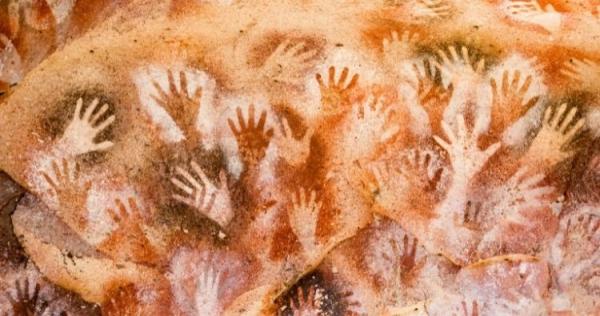 Famous paintings of hands. Image credit: Shutterstock
Famous paintings of hands. Image credit: Shutterstock
The patterns and meanings may vary, but they all carry their own historic or symbolic value and are nothing less than intriguing art. One of the sources to know about man’s artistry is rock art. Considering that, please read the list below of the 10 such rock art from ancient history that you’ll really find interesting
1. Bir Hima, Saudi ArabiaThe Bir Hima rock art site in Saudi Arabia is full of rock petroglyphs and inscriptions. The art can be dated back to Palaeolithic and Neolithic times, and it covers the time span of 2500 to 1000 BCE. Thousands of petroglyphs that depict humans and camels and a handful depicting giraffes and other animals were found in the 1950s.
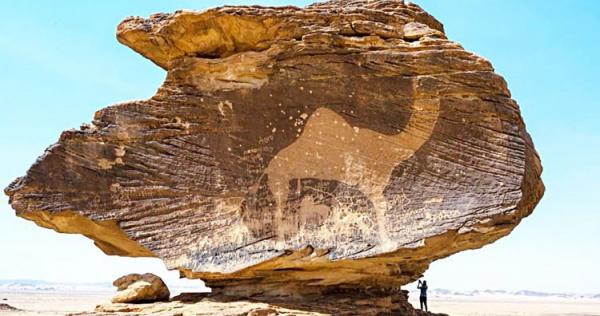
ShareA camel petroglyph at the Bir Hima. Image credits: Reddit
The ancient site of Bir Hima is located in the Najran Province, 200 kilometers away from the city of Najran. Many of the carvings show human cavalry and infantrymen engaged in battles wielding weapons.
Other petroglyphs noticed on the site were those of ostriches, domestic cattle, camels, and even date palms. There are approximately 18,000 carvings along of camels and 1,300 of human figures. The figures don’t exclude female images with some interpreted as the Goddess Al-Lat, but that has not been confirmed.
The rich ancient site was discovered by Philby Lippen and was written about by E. Anati in 1951. Some parts of the art are so dense that once an expedition member recorded 250 images at a single place. (1, 2)
2. The Cave of Altamira, SpainThe Cave of Altamira in Spain has one of the finest examples of prehistoric paintings and engravings. The cave is known for its charcoal drawings, polychrome paintings of local fauna, and human hands. These are the first European paintings that are of prehistoric origin.
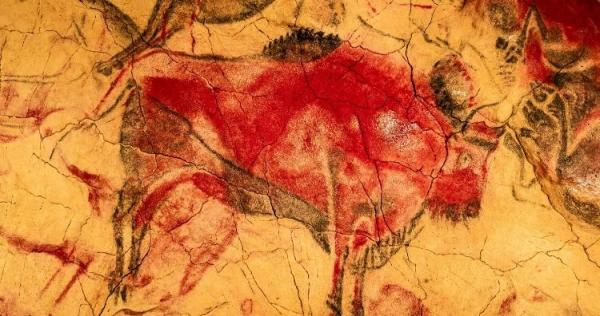
ShareRed bison from Altamira Cave. Image credit: Shutterstock
The town of Santillana del Mar in which the cave is located also has some historical significance. The earliest artwork can be dated back to 36,000 years ago but was discovered in 1868.
The discovery was actually made by a hunter, and it was only 10 years later that a local nobleman, Marcelino Sanz de Satuola, worked on its excavation and exploration. The paintings of the cave were not even accepted as genuine until the end 19th century.
The entire cave is 971 feet long and the height varies from 3.8 to 8.7 feet. The theme of the paintings is centered on animals and filled with figures of bison. Many of the engraved paintings appear three-dimensional because of the artist’s heavy work on the surface of the rocks. (1, 2)
3. Ubirr, AustraliaUbis is a rock formation at Kakadu National Park in Australia and has a vast collection of Aboriginal rock paintings and rock art. The paintings feature a variety of topics like animals, traditional x-ray art, and the first human contact with Europeans that are painted since 40,000 BCE.
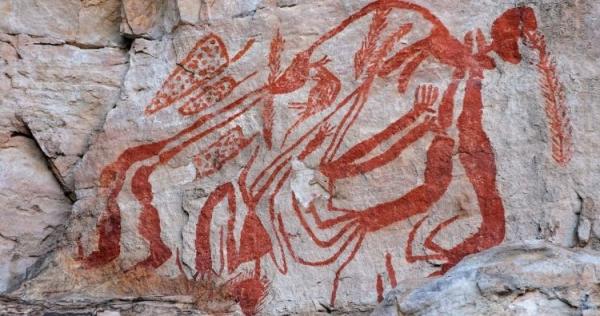
ShareAboriginal rock art at Ubirr, Kakadu National Park, Northern Territory, Australia. Image credit: Shutterstock
The Kakadu National Park lies in the Northern Territory of Australia and has a number of ancient art galleries. The paintings at Ubirr are mostly of animal figures that include catfish, mullet, barramundi, turtles, wallabies, etc.
These paintings were not painted in one stroke, rather they were painted and re-painted for years by different artists starting from 40,000 BCE. However, most of the paintings can be traced back to 2,000 years ago, and some even have been repainted in modern times.
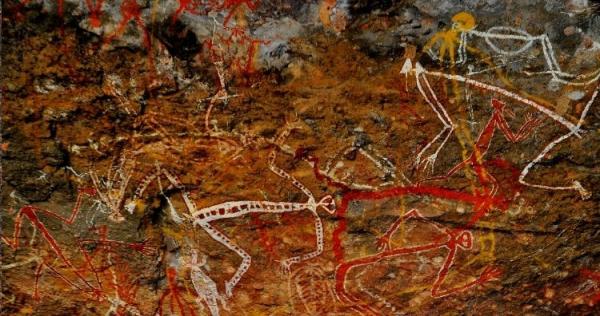
ShareRock art. Image credit: Shutterstock
The most popular site at Ubirr is the Rainbow Serpent Gallery which is traditionally a women-only site.
Most of the paints used by the artists were derived from the pigments crushed on stone palettes. For brushes, they used human hairs, feathers, chewed sticks, and reeds. One can notice that almost all the paintings are red in color, and the reason is that they are painted with haematite, a reddish iron oxide that lasts the longest of all colors. (1, 2)
4. The Giraffe Carvings, NigerThe Giraffe carvings in the Sahara Desert in Niger are said to be the largest petroglyphs in the world. There are two life-size-giraffe images, and the bigger one of them is 20 feet in height, being the largest known single prehistoric art piece in the world. The petroglyphs are 7,000 to 9,000 years old.

ShareTwo life-size-giraffe carved in a stone. Image credit: bradshawfoundation
The art is also known as “Dabous Giraffe,” and the art form in which the images are created is called “Bubalus style.” The images are carved out of several small engravings that collectively look like a picture of a giraffe. The art style has been observed to be prominent in the Large Wild Fauna Period or 9,000 to 6,500 BCE.
The dedication towards the art shows that the creature was significant to early African lives. Both the giraffe figures connect to a human figure through a long line that has some shamanic interpretations in symbolism. Most likely, it symbolizes the onset of rain, but it is not entirely clear.
The findings were recorded by photographer David Coulson of the Trust for African Rock Art (TARA) and French archaeologist Jean Clottes. (source)
5. Cave of Hands, ArgentinaOne of the earliest and unusual arts can be found in the Cave of Hands in Patagonia, Argentina. These are interesting stencil paintings of handprints and animals that are as old as 10,000 years old.
The remote cave is also known as “Las Cueva de Las Manos” and is situated in the valley of the Pinturas River. There are three different categories of paintings that can be found inside the cave, but the most recognized art is the hand paintings.
These are literally hundreds of colorful stencil paintings of handprints on the cave walls that are nearly 5,000 years old. It is believed that the dwellers that visited the caves left their handprints on the wall.
Other paintings involve representations of animals and human figures that are also drawn by stencil technique are older than the handprints. These figures are mostly reddish in color.
The cave was discovered in 1949 by researchers, but it was studied extensively only after 1960. The cave was also declared a UNESCO World Heritage Site in 1999. (1, 2)
6. Magura Cave, BulgariaThe ancient wall paintings on the walls of Magura Cave in Bulgaria are excellent expressions of the meaningful art of the European post-Palaeolithic period. The paintings found in Magura caves also resemble the ones that are discovered in Deer Cave in Italy.
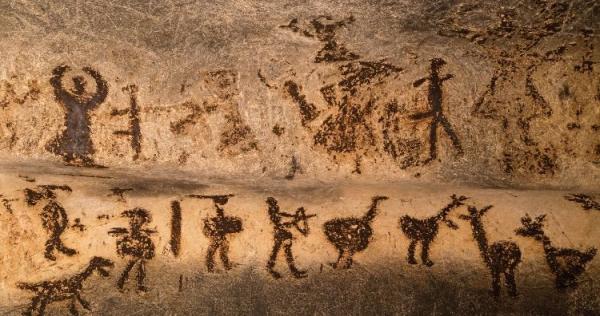
ShareBeautiful cave paintings dating from the late Neolithic, Epipaleolithic, and early Bronze Age. Image credit: Shutterstock
The cave is located near the town of Belogradchik in Vidin Province and is 2.5 kilometers long. The cave is said to be 15 million years old, but the paintings are estimated to be around 10,000 to 8,000 years old.
A variety of social practices and events are interpreted from the paintings found in the cave. The most common of them are religious ceremonies, hunting scenes, figures of deities, etc.
The paintings can be broadly categorized into four major groups: anthropomorphic, zoomorphic, geometric, and symbolic. Scratches and marks on the walls have been found in 1993, and since then, the paintings are protected with utmost care. Now, one can only see them in the presence of a tourist guide. (source)
7. Kimberley Wandjina Art, AustraliaThe Wandjina style of rock painting can be exclusively found in the Kimberley region in Australia, and it is insanely creative. These paintings have mythological figures closely related to the creation of the world and are created by Australian Aboriginals.

ShareRock art in Wandjina style. Image credit: Claire Taylor via Wikimedia
Also commonly referred to as the “Wandjina” style, these Aboriginal artworks of paintings are around 4,000 years old. The term “Wandjina” is closely related to spirits of clouds and rain in Aboriginal Mythology.
The figures in the paintings look like some kind of ghosts and are generally without a mouth. The head is always oversized in the figures and is surrounded by a halo and lines growing outwards. The color combination is white and red symbolizing water and blood.
The paintings are still believed to possess powers and are treated with respect. It is also surprising that each site and painting has an individual name.
The Mowanjum community ensures the future presence of Wandjina by repainting them in December or January every year. (1, 2)
8. Chiribiquete National Park, ColumbiaThese red-colored paintings on white rocks have been found in an extremely unexplored area of Chiribiquete National Park, Columbia. The images are 20,000 years old and are possibly made by the Karijona Tribe that still lives in the region.
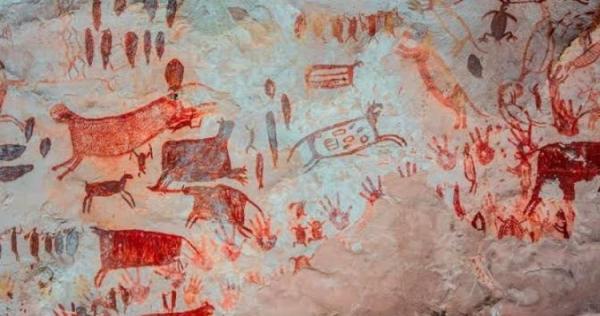
Rock art. Image credit: Jorge Mario Àlvarez Arango via whc.unesco
The site was discovered by a British wildlife filmmaker and photographer, Francisco Bonell. The place at which the prehistoric paintings were found is nearly inaccessible because it is in the heart of the jungles of Columbia. Even Francisco needed a helicopter for his expedition.
The hundreds of figures drawn on the stones are of jaguars, crocodiles, and deer. There are a few human figures, and one of them particularly interested the researcher. It showed a human sitting in a position with his arms folded over his shoulders. It is a ritual position still found in Amazonian cultures.
Other paintings that were discovered later were those of snakes, anteaters, and capybaras, which collectively mean that the people who lived and drew the pictures were afraid of and respected the wildlife very much. (source)
9. Utah, AmericaThe wide variety of petroglyphs and rock art in Utah is exceptional. Rock carvings at some sites range from 800 to 10,000 years old. There are not just figures but also writings that have been found across the ancient site.
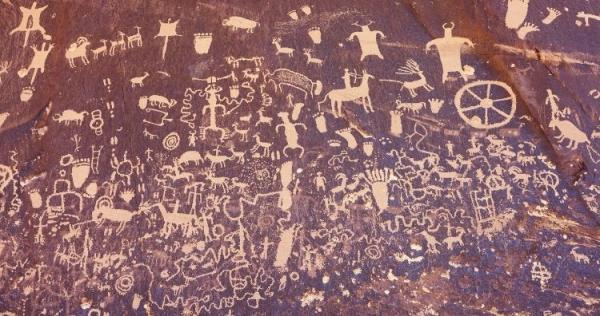
ShareAncient symbols texture, Petroglyphs on Newspaper Rock, Utah, USA. Image credit: Shutterstock
Most of the art found in Utah is made by the Fremont Indians, tribes who resided in the place from 800 to 1,500 ago and practiced a farming-based culture.
The images and representations drawn are really vivid, and every new figure seems different. The reason for that is the paintings were not created at a single time. Different people came and left their art at different points in time.
Some images show hunters with spears, bows, and arrows, whereas some have figures of horses and other animals. These different artworks represent multiple ranges of things such as routine habits, lifestyle, cattle they herded, rituals, mythology, etc.
The popularity gained by the ancient site has resulted in repeated vandalism and destruction of art. (source)
10. Saimaluu Tash, KyrgyzstanSailmaluu Tash is an ancient site in Kyrgyzstan with more than 10,000 carved pictures that date back between the third to eighth centuries. These black and white petroglyphs are an important part of the global collection of rock art.
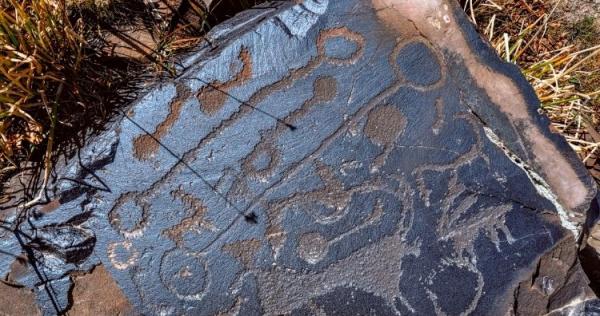
Ancient petroglyphs engraved on a rock on Saimaluu Tash site in Kyrgyzstan. Image credit: Shutterstock
The meaning of the phrase “Saimaluu Tash” means the “place of embroidered or patterned stones” in the local language. It is located in a valley near Kazarman Village in Jalal-Abad Province. The creation is estimated to have begun in the Neolithic and Bronze Age and continued until the Iron Age.
The themes of the carvings are very generic. Some show men hunting wild animals, some have people tilling the agricultural land, some figures also show rituals and dancing, and others show gratitude towards natural resources such as the Sun, rivers, mountains, etc.
Most of the carvings are done on basalt stones and have the strange color scheme of black and white, but that’s exactly what sets them apart from the other rock art found at other places in the world. (1, 2)
Related Post
A shocking documentary proves that mermaids do exist
SHOCKING Revelation: Thuya, Mother of Queen Tiye, Was the Grandmother of Akhenaten and Tutankhamun—What Ancient Egyptian Secrets Did She Leave Behind?
Breaking News: Astonishing Discoveries at Karahan Tepe Confirm an Extraterrestrial Civilization is Hiding on Earth, and NO ONE Knows!
Breaking News: Researchers FINALLY Discover U.S. Navy Flight 19 After 75 Years Lost in the Bermuda Triangle!
NASA’s Secret Investigation: Uncovering the Astonishing Mystery of the UFO Crash on the Mountain!
Explosive UFO Docs LEAKED: Startling Proof That Aliens Ruled Ancient Egypt!